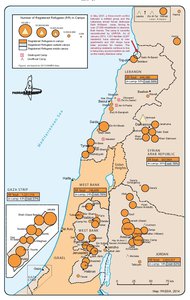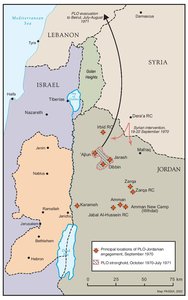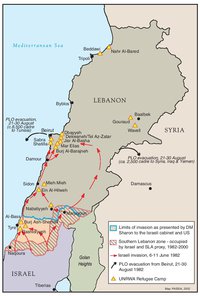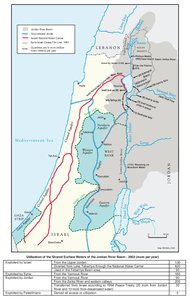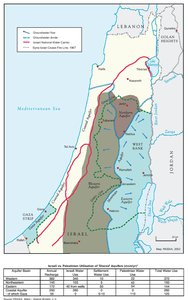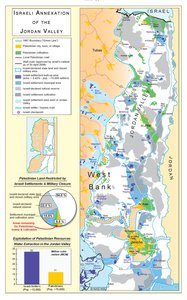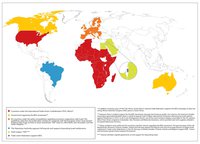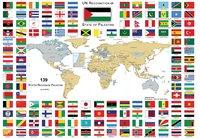PALESTINIAN REFUGEES
Map Details
Following the 1948 War, the UN Conciliation Commission estimated that 726,000 Palestinians (75% of the Arab population of Palestine) had been forced to flee, or had been expelled outside of what became Israel to neighboring Arab countries and elsewhere (known as the 1948 refugees). Of the 800,000 Arabs originally living in the area that became Israel, only some 100,000 remained, becoming an Arab minority in Israel. Up to 531 villages and towns were destroyed or resettled with Jews. In addition to the refugees, some 30-40,000 internally displaced Palestinians were expelled from their villages - located in what became Israel - during the war and were not allowed to return to their homes. They were placed under military rule to facilitate the expropriation of their land. Israel has never recognized internally displaced Palestinians, whose number (including their descendants) is now estimated at over 335,000. Palestinians who were expelled or fled the violence in and around 1948 were effectively denationalized when the Knesset passed the Israeli Nationality Law in 1952 (which required proof of citizenship pre-1948). Properties belonging to refugees were seized and transferred to the state of Israel. In the course of the June War of 1967 (the Naqsa), the remaining parts of Palestine (along with the Syrian Golan Heights and Egypt’s Sinai Peninsula) came under Israeli occupation. The UN estimated the number of new refugees (1967 refugees or 1967 displaced persons) as a direct result of the war at around 350,000. Other estimates suggest that of a pre-war population of 1.4 million Palestinians in the West Bank and Gaza Strip, approximately 430,000 fled their homes. Of these, 240,000 persons were displaced for a first time and 193,500 for a second time. The majority ended up in Jordan, where UNRWA established additional refugee camps to accommodate them. Today, the total Palestinian refugee population is estimated at around 7.4 million (about 64% of the worldwide Palestinian population, making Palestinians the largest single group of refugees in the world). These refugees include: - 5.3 million persons registered with UNRWA; - 335,000 internally displaced persons in Israel (from 1948)and their descendants; - some 940,000 displaced persons from 1967; - and over one million refugees who are not registered because of UNRWA’s narrow definition of who is a Palestine refugee, including refugees who fled to countries where UNRWA does not operate, who fled but were not in need for assistance, or who missed the deadline to register. The majority of refugees live in the West Bank and Gaza (where they account for 44.2% of the total population) or neighboring countries. Some 29% of registered refugees live in one of the 59 UNRWA camps, while the remainder lives outside the camps. Around half of the refugees are stateless and 40-50% of refugees are under the age of 15. Following the Oslo Accords, all camps in the West Bank and Gaza, apart from Shu’fat camp in Jerusalem, came under the control of the PA. According to UNRWA, as of July 2013 there were 1,970,009 registered refugees in the West Bank and Gaza Strip. They account for 44.2% of the total population (27% of the total West Bank and 67% of the total Gaza population). Outside the OPT, the refugees’ situation has always varied depending on their respective host country. Israel has always refused to accept any moral or historical responsibility for the creation of the refugee problem and as such rejected the refugees’ right to return and to compensation, which is enshrined in international conventions and particularly in UN Resolution 194 of 1948, which has been affirmed by the UNGA over 110 times. Postponing the refugee issue to final status talks - along with the core issues of settlements, water, borders and Jerusalem - marginalized the plight of the refugees and ignored the fact that without a just solution to the refugee problem there can be little hope of ending the Palestinian-Israeli conflict. The three key concepts that have shaped the discussion in negotiations so far are Repatriation (implementation of UN Resolution 194, i.e., the right of return), Compensation (various scenarios for financial reparation), and Resettlement (either in the Palestinian state, as naturalization in host counties with improved living conditions, or in third countries). In the recent (meanwhile stalled) talks to draw up a framework peace agreement, US Secretary of State John Kerry reportedly proposed to President Abbas the return of 80,000 Palestinian refugees to Israel, a number Abbas wanted to increase to 200,000. Leaks from the talks suggested that Palestinians were offered a land swap deal by which they would be given part of the Negev to settle refugees in exchange for giving up settlement blocs and the right of return. Compensation for 1948 refugees was also discussed, although combined with that of compensation for Jews forced to leave their homes in Arab nations.

